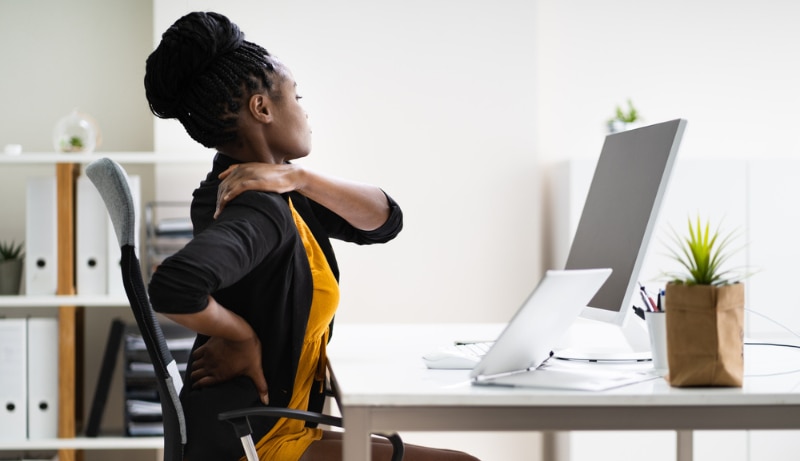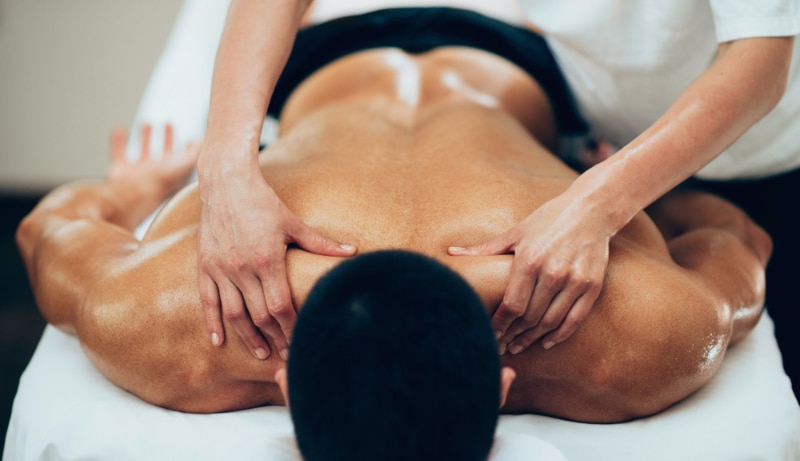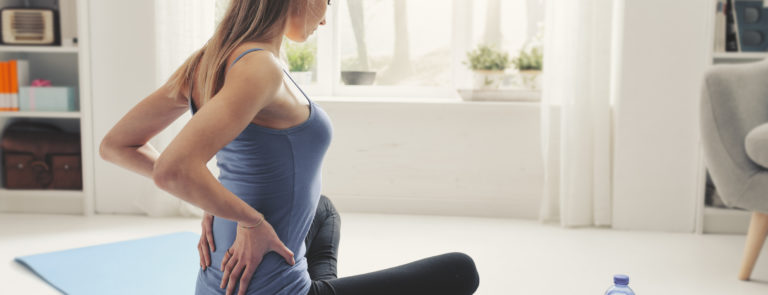15% off €35 OR 20% off €45
Our favourite natural solutions for joint pain

Discover how natural solutions can help to ease the symptoms of your joint pain, from exercise and posture to diet and massage therapy. There are many ways in which we can support our joints, and plenty of natural solutions to try reducing or preventing joint pain.
It’s also important to remember that joint pain can affect anyone, at any age! So, finding natural solutions to this could be helpful to you and your family.
What is joint pain?
Joint pain can be discomfort, pain or inflammation arising from any part of a joint – including cartilage, bone, ligaments, tendons or muscles.1
Joint pain can be mild, causing soreness only after certain activities, or it can be severe, making even limited movement, particularly bearing weight, extremely painful.
It’s important to bear in mind that people at any age can suffer from joint pain, and not just the elderly. For more information on this, visit our article "Arthritis isn't just an "old" person's disease: Here's what you need to know".


Where can we get joint pain?
Joint discomfort is common and usually felt in the hands, feet, hips, knees, or spine. Pain may be constant, or it can come and go. Sometimes the joint can feel stiff, achy, or sore. Some people may even experience a burning, throbbing, or “grating” sensation.2
Is there anything we can do to prevent joint pain?
There are many simple preventions you can do to protect your joints, reduce strain, and improve how you function each day. Ditching the heels from time to time could lessen the stress on your knees, warming up before working-out will ensure optimal joint safety, and eating plenty of calcium rich food sources such as yoghurt, broccoli, kale, figs, and salmon can help to build and maintain bone strength.3
Neither sitting nor standing on your feet all day is good for your joints. When possible, alternate between the two to prevent stiffness and strain. If your job primarily involves sitting, try to take a break and stand up every 30 minutes or so. Whether at home or the office, make time for simple stretches throughout the day.4
Working from home (WFH) has become a rather universal way of working over the past few years. Though WFH has its many perks, with it can come inadequate equipment that doesn’t safely support your posture or new working environment. Visit Is working from home causing you back pain? for more information on this if you feel you're affected.


The difference between pain after exercise and recurring joint pain
It’s normal to have some pain, stiffness, and swelling after starting a new physical activity program. It may take 6 to 8 weeks for your joints to get used to your new activity level.5 Usually, your muscles will stop aching in 2 to 5 days and you won't need any medical attention. You should be able to ease symptoms yourself.6
However, if you're experiencing recurring joint pain, or if joint pain is severe or stopping you from doing normal activities, then it’s best to see your GP or a healthcare professional, as they will be able to give you personalised advice that is tailored to you, your body and your symptoms.
1. Exercise
Exercise and movement in general are probably one of the best ways to support your joint, bones, and muscles – and to potentially alleviate any pain you might be experiencing within your joints. You should try to include a combination of exercises into your daily routine, that can strengthen your muscles and improve your general fitness.
Regular physical activity can keep the muscles around affected joints strong, decrease bone loss and may help control joint swelling and pain. Regular activity replenishes lubrication to the cartilage of the joint and reduces stiffness and pain.7
Adults should aim to be active daily; over a week, activity should add up to at least 150 minutes of moderate intensity activity in sessions of 10 minutes or more. One way to approach this is to do 30 minutes a day, for 5 days of the week.8
Our neck and shoulders can easily bear the burden of stress-induced pain, as a result of constant tension of the neck and shoulder muscles.9
There are several movements you can do that may help exercise your shoulders and eventually reduce pain; check out 9 exercises for shoulder pain for a step by step run through of the many variations.


2. Yoga
If you haven’t tried yoga yourself, you’ve probably at least heard of it or know someone who has participated in a class or two. You might be wondering, What is yoga?. But, for now, let’s focus on how it can be beneficial for your joints.
Not only can yoga support the mind, but it is a great way to build strength and flexibility in your joints. It may also improve your balance, working muscles in the knees, ankles, and hips.
Yoga presents certain poses that are optimised to promote joint health and pain-free movement, including:
- The Bridge Pose
- Warrior Pose
- Forward Fold
- Blank Pose
- Bow Pose
- Bound Angle Pose
Each of these yoga poses help to strengthen your joints, relax stiff muscles and aid them to stretch, whilst supporting your overall joint health.
3. Diet
Food and diet can have a big impact on the health and longevity of your joints. It’s good to be mindful on what we put into our bodies and the repercussions this might have.
The Eatwell Guide shows how much of what we eat overall should come from each food group to achieve a healthy, balanced diet. There are 5 main food groups within the Eatwell Guide – it’s recommended to choose a variety of different foods from each of the groups to help you get the wide range of nutrients your body needs to stay healthy.10
Omega-3 can be found in cold-water fish such as tuna, salmon, trout, halibut, and sardines. Salmon and trout also contain vitamin D, as does cod liver oil. Sardines contain a good source of calcium. You need sufficient calcium to keep your bones healthy and vitamin D to help your body absorb calcium.11
Almonds, hazelnuts, peanuts, pecans, pistachios and walnuts contain high amounts of fibre, calcium, magnesium, zinc, vitamin E and omega-3 fats which all have anti-inflammatory effects.12


Dark leafy green vegetables are often rich in vitamin K. In a study published by The American Journal of Medicine, they found vitamin K deficiency was associated with increased risk of developing radiographic knee osteoarthritis and MRI-based cartilage lesions.13
The nutrients in bone broth are known to have many health benefits. When bone broth is being made, the simmering of the bones and ligaments causes them to release healing compounds like collagen, proline, glycine, and glutamine.14 Functions of proline include helping to form collagen and connective tissue, supporting the regeneration of cartilage and helping to maintain joints.15 Bone broth is associated with collagen, a structural protein found in skin, cartilage and bone.16 For more collagen rich foods and joint supporting ingredients, have a browse through our 15 collagen rich foods and drinks article.
4. Sleep
A study published called 'Sleep Loss Exacerbates Fatigue, Depression, and Pain in Rheumatoid Arthritis' found the first evidence of an exaggerated increase in symptoms of mood and pain in patients with rheumatoid arthritis after sleep loss, along with an activation of rheumatoid arthritis-related joint pain.17
Changing your sleep position or even your mattress could help you obtain a better night’s sleep. Using a pillow wedge, a leg positioner pillow or a knee cushion could also support your joints whilst you sleep and assist with easing painful joints.
Sleepers with arthritis often appreciate mattresses made with adaptive foam comfort systems, which typically offer excellent pressure relief for the joints.18


5. Posture
Maintaining good posture helps us develop the correct alignment between our bones and joints.19 Posture can affect our joints in a big way; the way we stand, sit at our desks or even how we hold our electronic devices.
Working from home may affect our posture too, with not having the same set up as you would if working from an office. For example, forearms should be approximately horizontal, and your eyes should be the same height as the top of the screen. For more guidance on this, check out 5 things everyone WFH should know about their body.
Forward head posture, now also known as “nerd neck”, occurs when your neck slants forward, placing your head in front of your shoulders. It’s caused by bad habits, such as spending long periods sitting at your computer or looking down at your phone.20 Find out what you can do to correct your posture when sitting at your desk by reading through our Do you have nerd neck? blog.
6. Electric muscle stimulators and massage therapy
Electric muscle stimulator (EMS) machines are designed to help strengthen and rehabilitate your muscles using tiny electrical impulses to produce a muscle contraction that is thought to help your muscles back to recovery. Find out more about electric muscle stimulators and how they work by having a browse at 3 of the best electrical muscle stimulators on offer.
Massages are good for joint pain as they help to relax the muscles and boost circulation, relieving tension. As is hot and cold therapy, which can also reduce joint pain.
Massage therapy may help with inflammatory types of arthritis as well. Therapeutic massage treatments, while able to achieve qualitative muscle release in an affected joint region, can also positively affect the physiological systems of a patient with Rheumatoid arthritis and help to alleviate and prolong the deteriorating effects of the disease.21
If you’re interested in trying one of the many types of massage to ease your arthritis symptoms, it’s important to consult your rheumatologist or primary-care physician first to ensure that massage is safe for you.21


Taking a long, warm bath or shower can relieve muscle pain or tension, especially if you’re experiencing pain in the neck and shoulder joints. Likewise, a cold press can also help to relieve joint pain, swelling or inflammation. To find out more about these natural reliefs visit 8 joint pain relief remedies.
The final say
Keeping your joints in good health is important for multiple reasons. There are many natural solutions you can try to support your joint health – keeping those hip joint problems and stiff knees at bay. If you still find yourself searching for more information or extra guidance on all things joints, then jump on over to our dedicated joints page on the Health Hub.
Please note that the information in this article is only top-level guidance, and if you’re experiencing symptoms it may be worth checking in with a medical professional for personalised advice.
- https://www.mayoclinic.org/symptoms/joint-pain/basics/definition/sym-20050668#:~:text=Joint%20pain%20can%20be%20discomfort,from%20within%20the%20joint%20itself
- https://my.clevelandclinic.org/health/symptoms/17752-joint-pain#:~:text=Joint%20discomfort%20is%20common%20and,%2C%20or%20%E2%80%9Cgrating%E2%80%9D%20sensation
- https://www.bda.uk.com/resource/calcium.html
- https://www.arthritis.org/health-wellness/healthy-living/managing-pain/joint-protection/16-joint-protection-tips
- https://www.cdc.gov/arthritis/basics/physical-activity/pain.html
- https://www.nhsinform.scot/healthy-living/keeping-active/before-and-after-exercise/pain-and-injuries-after-exercise#:~:text=Sore%20muscles%20after%20exercise,a%20bit%20harder%20than%20usual
- https://www.hopkinsarthritis.org/patient-corner/disease-management/role-of-exercise-in-arthritis-management/#:~:text=Regular%20physical%20activity%20can%20keep,and%20reduces%20stiffness%20and%20pain
- https://assets.publishing.service.gov.uk/government/uploads/system/uploads/attachment_data/file/833126/dh_128145.pdf#:~:text=Adults%20should%20aim%20to%20be%20active%20daily.%20Over,week.%20Alternatively%2C%20comparable%20benefits%20can%20be%20achieved%20through
- https://cmrc.com/how-stress-leads-to-neck-and-shoulder-pains/#:~:text=Our%20neck%20and%20shoulders%20are,the%20neck%20and%20shoulders%20muscles
- https://www.nhs.uk/live-well/eat-well/food-guidelines-and-food-labels/the-eatwell-guide/
- https://www.nhs.uk/live-well/bone-health/food-for-strong-bones/
- https://www.pennmedicine.org/updates/blogs/musculoskeletal-and-rheumatology/2018/may/seven-foods-to-help-you-fight-arthritis#:~:text=Almonds%2C%20hazelnuts%2C%20peanuts%2C%20pecans,all%20have%20anti%2Dinflammatory%20effects.
- https://www.amjmed.com/article/S0002-9343(12)00881-9/fulltext
- https://draxe.com/nutrition/bone-broth-benefits/
- https://www.adashiko.com/blogs/news/super-amino-acids-glycine-and-proline .
- https://www.bbcgoodfood.com/howto/guide/health-benefits-of-bone-broth
- https://www.ncbi.nlm.nih.gov/pmc/articles/PMC3296796/
- https://www.sleepfoundation.org/best-mattress/best-mattress-for-arthritis#:~:text=Sleepers%20with%20arthritis%20often%20appreciate,pressure%20relief%20for%20the%20joints
- https://pruskijointandspine.com/the-importance-of-good-posture-to-reduce-joint-pain/#:~:text=Maintaining%20a%20good%20posture%20helps,degenerative%20arthritis%20and%20joint%20pain
- https://www.absolutelifewellnesscenter.com/how-to-fix-forward-head-posture/#:~:text=What%20is%20Nerd%20Neck%3F,looking%20down%20at%20your%20cellphone
- https://www.massagetoday.com/articles/13716/Researching-the-Effects-of-Massage-Therapy-in-Treating-Rheumatoid-Arthritis
- https://www.arthritis.org/health-wellness/treatment/complementary-therapies/natural-therapies/benefits-of-massage



